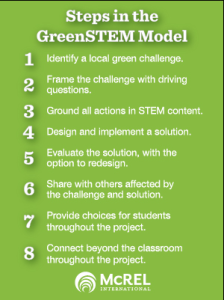
GreenSTEM is an engaging project-based approach that uses science, technology, engineering, and math (STEM) content and practices to investigate local environmental problems, and design and implement solutions. GreenSTEM projects like the creek example comprise all eight steps (see graphic), which are woven throughout the lessons, and can last a week, month or the entire school year. Authentic and relevant GreenSTEM lessons that focus on only one step can be explored in only one or two class periods.
Steps we took in the GreenSTEM Creek Mitigation Project
Identify a local green challenge. We identified the poor water quality of the neighborhood creek as the challenge.

Ground all actions in STEM content. Using science, math, and technology (i.e., the modification of a natural resource to meet the needs or wants of the community), the 5th graders investigated and gathered data to describe the problems with water and soil quality, macroinvertebrate diversity, erosion and deposition, and invasive plant species. This evidence became the guideposts for designing solutions to modify the creek.
Design and implement a solution. In a dynamic engineering design process, students design a solution, test it, modify the design based on test results, and test again. This is not always easy in some real-world GreenSTEM projects. In the creek mitigation case, the 5th graders discovered that any of their design solutions addressing erosion, eutrophication, and current placement of large rocks in the creek channel could only be implemented by, or with permission from, the local water district authorities because of environmental protection laws. This made collaboration with these community experts essential to the project’s success. Students gathered the data on their designs through stream table channel modeling and presented their evidence and design solution recommendations to the authorities. At this point, if the authorities chose to implement their design, students would then be able to gather comparison data, allowing them to enter another improvement cycle in the engineering design process.*

Share with others affected by the challenge and solution. Because students had very limited control in testing any solutions to the creek’s water quality, they became the engineer liaisons, offering their evidence-based solutions to the attention of the legal decision-makers. Students prepared and gave presentations to key stakeholders from the city and county water authority, school and district administrators, and interested community members.
Provide choices for students throughout the project. Real-world projects like this creek project are equally exciting for both teachers and students, who become co-learners by exploring, discovering, designing, and testing together. There is no preset answer or “right” solution. Given the latitude to make choices in GreenSTEM projects, students often discover new aspects of the challenge and come up with more innovative ideas than the teacher could have imagined.
Connect beyond the classroom throughout the project. School and community stakeholders were not aware of the creek quality issue and its effect on community activities until students met with them. Because their suggestions were data-driven and evidence-based, the water district professionals, and community members initiated high-level discussions with students about their findings and solutions, and then took the information back to their agencies and leadership for further discussions about implementation.
GreenSTEM projects can continue to inspire students far beyond the classroom—even over a lifetime—through ongoing student engagement in community issues and the pursuit of “green” jobs and higher-education opportunities in STEM. This revelation became clear to a GreenSTEM educator workshop participant, who expressed it so powerfully:
“The human mind continues to process unresolved questions long after the question is asked. Even if a classroom never solves a GreenSTEM issue, those 30 minds will continue to churn on the problem. Perhaps someday, one or two of these minds will find an answer to the problem.”
*Note: The water authorities were grateful to the students for bringing this problem and some solutions to their attention, but chose not act on the recommendations, citing flood control engineering design as the priority to an unimpeded channel with improved water quality. This lesson in civics enhanced the students’ authentic community GreenSTEM project.

Additional resources
